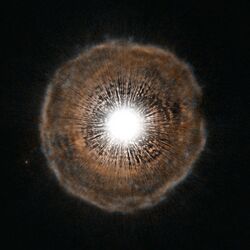Astronomy:U Camelopardalis
Coordinates: ![]() 03h 41m 48.17393s, +62° 38′ 54.3906″
03h 41m 48.17393s, +62° 38′ 54.3906″
| Observation data Equinox J2000.0]] (ICRS) | |
|---|---|
| Constellation | Camelopardalis |
| Right ascension | 03h 41m 48.17393s[1] |
| Declination | +62° 38′ 54.3906″[1] |
| Apparent magnitude (V) | 7.55[2] |
| Characteristics | |
| Spectral type | C-N55.5 (MS4)[3] |
| U−B color index | +3.50[2] |
| B−V color index | +1.95[2] |
| Variable type | SRb[4] |
| Astrometry | |
| Radial velocity (Rv) | -3.00[5] km/s |
| Proper motion (μ) | RA: 3.50[1] mas/yr Dec.: -3.62[1] mas/yr |
| Parallax (π) | 1.03 ± 0.59[1] mas |
| Distance | 530[6] pc |
| Absolute magnitude (MV) | −2.4 (max)[7] |
| Details | |
| Luminosity | 8,472[8] L☉ |
| Temperature | 3,000[9] K |
| Other designations | |
| Database references | |
| SIMBAD | data |
U Camelopardalis is a semiregular variable star in the constellation Camelopardalis. Based on parallax measurements made by the Hipparcos spacecraft, it is located about 3,000 light-years (1,000 parsecs) away from the Earth.[1] Its apparent visual magnitude is about 8, which is dim enough that it cannot be seen with the unaided eye.
The spectral type of U Camelopardalis in the revised MK system is C-N5, which indicates a classical carbon star spectrum approximately corresponding to late K or early M.[10] The C2 index is 5.5 which is typical of a C-N star.[11] It is also given an alternative spectral type of MS4, indicating a star similar to an M4 class but with somewhat enhanced ZrO bands.[3] The spectral type may vary between C3,9 and C6,4e.[4]

U Camelopardalis is a carbon star. These types of stars have greater levels of carbon in their atmospheres than oxygen, which means they form carbon compounds that make the star appear strikingly red. U Camelopardalis is nearly 4 magnitudes fainter at blue wavelengths than in the centre of the visual range. In the infrared K band it has an apparent magnitude of 0.37.[13] Its brightness varies without a dominant period and it is classified as semi-regular, although a period of 400 days has been published.[13] In the V photometric band the brightness varies by around half a magnitude,[14] but the amplitude is nearly two magnitudes at blue wavelengths.[4] The maximum visual magnitude has been given as 7.2.[7]
The shell of gas surrounding U Camelopardalis was imaged by the Hubble Space Telescope in 2012, showing a nearly perfect sphere of gas surrounding the star.[15]
U Cameloparadlis has a 10th magnitude companion 308" away. It is a B8 main sequence star, hotter but less luminous than U Cam itself. They are not thought to be physically associated.[7]
References
- ↑ 1.0 1.1 1.2 1.3 1.4 1.5 van Leeuwen, F. (2007). "Validation of the new Hipparcos reduction". Astronomy and Astrophysics 474 (2): 653–664. doi:10.1051/0004-6361:20078357. Bibcode: 2007A&A...474..653V. http://www.aanda.org/index.php?option=com_article&access=bibcode&Itemid=129&bibcode=2007A%2526A...474..653VFUL.
- ↑ 2.0 2.1 2.2 Nicolet, B. (1978). "Catalogue of homogeneous data in the UBV photoelectric photometric system". Astronomy and Astrophysics 34: 1–49. Bibcode: 1978A&AS...34....1N.
- ↑ 3.0 3.1 Barnbaum, Cecilia; Stone, Remington P. S.; Keenan, Philip C. (1996). "A Moderate-Resolution Spectral Atlas of Carbon Stars: R, J, N, CH, and Barium Stars". Astrophysical Journal Supplement 105: 419. doi:10.1086/192323. Bibcode: 1996ApJS..105..419B.
- ↑ 4.0 4.1 4.2 Samus, N. N. et al. (2009). "VizieR Online Data Catalog: General Catalogue of Variable Stars (Samus+ 2007-2013)". VizieR On-line Data Catalog: B/GCVS. Originally Published in: 2009yCat....102025S 1. Bibcode: 2009yCat....102025S.
- ↑ Gontcharov, G. A. (2006). "Pulkovo Compilation of Radial Velocities for 35 495 Hipparcos stars in a common system". Astronomy Letters 32 (11): 759–771. doi:10.1134/S1063773706110065. Bibcode: 2006AstL...32..759G. http://adsabs.harvard.edu/cgi-bin/nph-bib_query?bibcode=2006AstL...32..759G.
- ↑ Guandalini, R.; Busso, M.; Ciprini, S.; Silvestro, G.; Persi, P. (2006). "Infrared photometry and evolution of mass-losing AGB stars. I. Carbon stars revisited". Astronomy and Astrophysics 445 (3): 1069–1080. doi:10.1051/0004-6361:20053208. Bibcode: 2006A&A...445.1069G.
- ↑ 7.0 7.1 7.2 Olson, B. I.; Richer, H. B. (1975). "The absolute magnitudes of carbon stars - Carbon stars in binary systems". Astrophysical Journal 200: 88. doi:10.1086/153763. Bibcode: 1975ApJ...200...88O.
- ↑ Bergeat, J.; Chevallier, L. (2005). "The mass loss of C-rich giants". Astronomy and Astrophysics 429: 235–246. doi:10.1051/0004-6361:20041280. Bibcode: 2005A&A...429..235B.
- ↑ Tanaka, Masuo; Letip, Ahmatjan; Nishimaki, Yuichirou; Yamamuro, Tomoyasu; Motohara, Kentaro; Miyata, Takashi; Aoki, Wako (2007). "Near-Infrared Spectra of 29 Carbon Stars: Simple Estimates of Effective Temperature". Publications of the Astronomical Society of Japan 59 (5): 939. doi:10.1093/pasj/59.5.939. Bibcode: 2007PASJ...59..939T.
- ↑ Keenan, Philip C. (1993). "Revised MK spectral classification of the red carbon stars". Astronomical Society of the Pacific 105: 905. doi:10.1086/133252. Bibcode: 1993PASP..105..905K.
- ↑ Keenan, P. C.; Morgan, W. W. (1941). "The Classification of the Red Carbon Stars". The Astrophysical Journal 94: 501. doi:10.1086/144356. Bibcode: 1941ApJ....94..501K.
- ↑ "Download Data". AAVSO. https://www.aavso.org/data-download.
- ↑ 13.0 13.1 Knapp, G. R.; Pourbaix, D.; Platais, I.; Jorissen, A. (2003). "Reprocessing the Hipparcos data of evolved stars. III. Revised Hipparcos period-luminosity relationship for galactic long-period variable stars". Astronomy and Astrophysics 403 (3): 993–1002. doi:10.1051/0004-6361:20030429. Bibcode: 2003A&A...403..993K.
- ↑ Adelman, Saul J. (2001). "Stars with the Largest Hipparcos Photometric Amplitudes". Baltic Astronomy 10 (4): 589. doi:10.1515/astro-2001-0403. Bibcode: 2001BaltA..10..589A.
- ↑ "Red Giant Blows a Bubble". ESA/Hubble Picture of the Week. http://www.spacetelescope.org/images/potw1227a/.
 |


